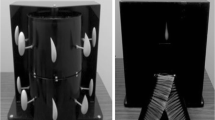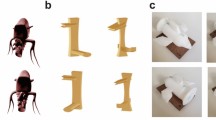Abstract
Real-world scene perception can often involve more than one sensory modality. Here we investigated the visual, haptic and crossmodal recognition of scenes of familiar objects. In three experiments participants first learned a scene of objects arranged in random positions on a platform. After learning, the experimenter swapped the position of two objects in the scene and the task for the participant was to identify the two swapped objects. In experiment 1, we found a cost in scene recognition performance when there was a change in sensory modality and scene orientation between learning and test. The cost in crossmodal performance was not due to the participants verbally encoding the objects (experiment 2) or by differences between serial and parallel encoding of the objects during haptic and visual learning, respectively (experiment 3). Instead, our findings suggest that differences between visual and haptic representations of space may affect the recognition of scenes of objects across these modalities.




Similar content being viewed by others
Notes
All the studies reported were approved by the Trinity College Department of Psychology Ethics Committee, and thus conformed to the ethical standards laid down in the 1964 Declaration of Helsinki.
An ISI of 20 s was necessary for the experimenter to move the objects. Although this ISI may contribute to a memory decay rate, a recent study suggests no difference in memory decay rates across vision and haptics (see Woods et al. 2004).
References
Aginsky V, Tarr MJ (2000) How are different properties of a scene encoded in visual memory? Vis Cogn 7:147–162
Avery GC, Day RH (1969) Basis of horizontal-vertical illusion. J Exp Psychol 81:376–380
Baddeley AD (1986) Working memory. Oxford University Press, Oxford, UK
Biederman I, Rabinowitz JC, Glass AL, Stacey EWJ (1974) On the information extracted from a glance at a scene. J Exp Psychol 103:597–600
Blumenfeld W (1937) The relationship between optical and haptic construction of space. Acta Psychol 2:125–175
Brockmole JR, Wang RF, Irwin DE (2002) Temporal integration between visual images and visual percepts. J Exp Psychol Hum Percept Perform 28:315–334
Christou CG, Bülthoff HH (1999) View dependence in scene recognition after active learning. Mem Cogn 27:996–1007
Day RH, Avery GC (1970) Absence of the horizontal-vertical illusion in haptic space. J Exp Psychol Gen 83:172–173
Diwadkar VA, McNamara TP (1997) Viewpoint dependence in scene recognition. Psychol Sci 8:302–307
Faineteau H, Gentaz E, Viviani P (2003) The kinaesthetic perception of Euclidean distance: a study of the detour effect. Exp Brain Res 152:166–172
Gentaz E, Hatwell Y (1998) The haptic oblique effect in the perception of rod orientation by blind adults. Percept Psychophys 60:157–167
Gentaz E, Hatwell Y (1999) Role of memorization conditions in the haptic processing of orientations and the ‘oblique effect’. Br J Psychol 90:373–388
Henderson JM, Hollingworth A (2003) Eye movements and visual memory: detecting changes to saccade targets in scenes. Percept Psychophys 65:58–71
Hollingworth A (2003) Failures of retrieval and comparison constrain change detection in natural scenes. J Exp Psychol 29:388–403
Hollingworth A, Williams CC, Henderson JM (2001) To see and remember: visually specific information is retained in memory from previously attended objects in natural scenes. Psychonom Bull Rev 8:761–768
Irwin DE, Zelinsky GJ (2002) Eye movements and scene perception: memory for things observed. Percept Psychophys 64:822–895
Kappers AM (1999) Large systematic deviations in the haptic perception of parallelity. Perception 28:1001–1012
Kappers AM, Koenderink JJ (1999) Haptic perception of spatial relations. Perception 28:781–795
Klatzky RL (1999) Path completion after haptic exploration without vision: implications for haptic spatial representations. Percept Psychophys 61:220–235
Kosslyn SM, Chabris CF, Marsolek CJ, Koenig O (1992) Categorical versus coordinate spatial relations: computational analyses and computer simulations. J Exp Psychol Hum Percept Perform 18:562–577
Lederman SJ, Klatzky RL (1987) Hand movements: a window into haptic object recognition. Cogn Psychol 19:342–368
Lederman SJ, Klatzky RL, Barber PO (1985) Spatial and movement-based heuristics for encoding pattern information through touch. J Exp Psychol Gen 114:33–49
Lederman SJ, Klatzky RL, Collins A, Wardell J (1987) Exploring environments by hand or foot: time-based heuristics for encoding distance in movement space. J Exp Psychol Learn Mem Cogn 13:606–614
Lederman SJ, Summers C, Klatzky RL (1996) Cognitive salience of haptic object properties: role of modality-encoding bias. Perception 25:983–998
Loomis JM, Klatzky RL, Lederman SJ (1991) Similarity of tactual and visual picture recognition with limited field of view. Perception 20:167–177
Mahrer P, Miles C (2002) Recognition memory for tactile sequences. Memory 10:7–20
Marchetti FM, Lederman SJ (1983) The haptic radial-tangential effect: two sets of Wong’s (1977) “moments-of-inertia” hypothesis. Bull Psychonom Soc 21:43–46
Marks LE, Armstrong L (1996) Haptic and visual representations of space. In: Inui T, McClelland JL (eds) Attention and performance, XVI. Information integration in perception and communication. MIT Press, Cambridge, MA, pp 263–287
McNamara TP (2003) How are locations of objects in the environment represented in memory? In: Freska C, Brauer W, Habel C, Wender K (eds) Spatial cognition, III. Routes and navigation, human memory and learning, spatial representation and spatial reasoning. Springer, Berlin Heidelberg New York, pp 174–191
Millar S (1975) Effects of tactual and phonological similarity on the recall of Braille letters by blind children. Br J Psychol 66:193–201
Nakatani C, Pollatsek A, Johnson SH (2002) Viewpoint-dependent recognition of scenes. Q J Exp Psychol 55A:115–139
Newell FN, Ernst MO, Tjan BS, Bülthoff HH (2001) Viewpoint dependence in visual and haptic object recognition. Psychol Sci 12:37–42
Newport R, Rabb B, Jackson SR (2002) Noninformative vision improves haptic spatial perception. Curr Biol 12:1661–1664
Postma A, de Haan EHF (1996) What was where? Memory for object locations. Q J Exp Psychol 49A:187–199
Potter MC (1976) Short-term conceptual memory for pictures. J Exp Psychol Hum Learn Mem 2:509–522
Rensink RA (2002) Change detection. Annu Rev Psychol 53:245–277
Rensink RA, O’Regan JK, Clark JJ (1997) To see or not to see: the need for attention to perceive changes in scenes. Psychol Sci 8:368–373
Rensink RA, O’Regan JK, Clark JJ (2000) On the failure to detect changes in scenes across brief interruptions. Vis Cogn 7:127–145
Salamé P, Baddeley AD (1982) Disruption of short-term memory by irrelevant speech: implications for the structure of working memory. J Verbal Learn Verbal Behav 21:150–164
Sanocki T (2003) Representation and perception of scenic layout. Cogn Psychol 47:43–86
Sanocki T, Epstein W (1997) Priming spatial layout of scenes. Psychol Sci 8:374–378
Simons DJ (1996) In sight, out of mind: when object representations fail. Psychol Sci 7:301–305
Simons DJ, Wang RF (1998) Perceiving real-world viewpoint changes. Psychol Sci 9:315–320
Simons DJ, Wang RF, Roddenberry D (2002) Object recognition is mediated by extraretinal information. Percept Psychophys 64:521–530
Tarr MJ, Bülthoff HH (1998) Image-based object recognition in man, monkey and machine. Cognition 67:1–20
Thorpe S, Fize D, Marlot C (1996) Speed of processing in the human visual system. Nature 381:520–522
Wang RF, Simons DJ (1999) Active and passive scene recognition across views. Cognition 70:191–210
Woods AT, O’Modhrain S, Newell FN (2004) The effect of temporal delay and spatial differences on crossmodal object recognition. Cogn Affective Behav Neurosci (in press)
Zuidhoek S, Kappers AML, van der Lubbe RHJ, Postma A (2003) Delay improves performance on a haptic spatial matching task. Exp Brain Res 149:320–330
Acknowledgements
This work was funded by a European Union IST programme grant (IST-2001-34712) awarded to the first author and by the Max-Planck Society, Germany. We thank Karl-Heinz Hofmann and Christina Baum of the Max-Planck Institute for Biological Cybernetics for building our experimental apparatus.
Author information
Authors and Affiliations
Corresponding author
Rights and permissions
About this article
Cite this article
Newell, F.N., Woods, A.T., Mernagh, M. et al. Visual, haptic and crossmodal recognition of scenes. Exp Brain Res 161, 233–242 (2005). https://doi.org/10.1007/s00221-004-2067-y
Received:
Accepted:
Published:
Issue Date:
DOI: https://doi.org/10.1007/s00221-004-2067-y




